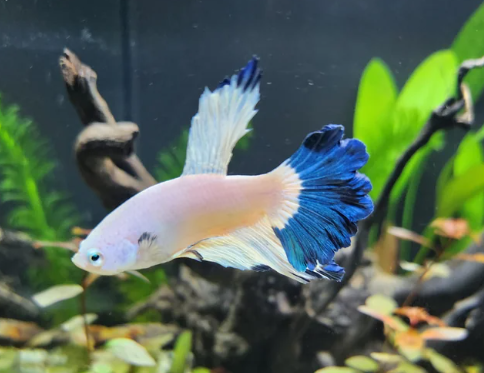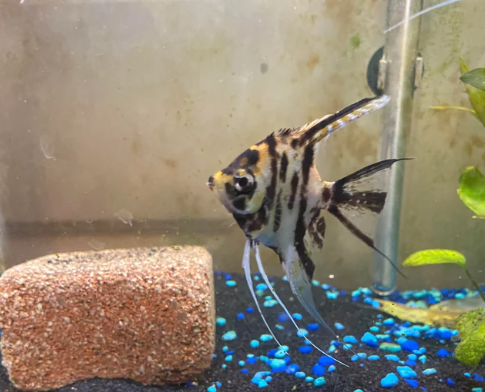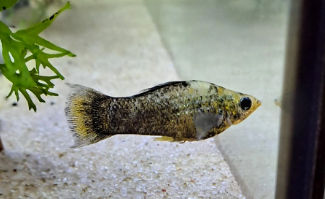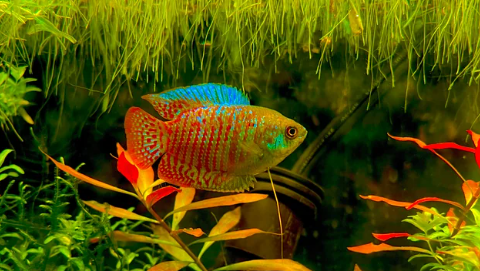Warm water or tropical fish need a certain threshold of water temperature to survive and thrive, for they have a faster metabolic rate and quicker growth rate. Moreover, as the water temperature is easier to raise than reduce to suit cold water species, warm water fishes are commonly found in the aquarium trade. They also are pretty popular with aquarists for their visual appeal.
In general, tropical waters, where the warm water fishes come from, experience a water temperature of around 78 Fahrenheit or 25 Celcius throughout the year. The fish species discussed in this article mostly are from the same region and have specific care requirements in addition to temperature, which we’ll discuss in the subsequent sections.
Table of Contents
Top 10 Warm Water Fishes
1. Discus
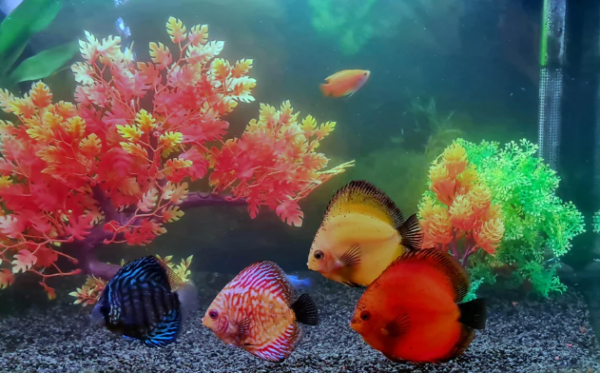
| Information Chart | Discus |
| Scientific Name: | Symphysodon spp. |
| Family: | Cichlidae |
| Care Level: | Advanced |
| Temperament: | Generally peaceful |
| Color: | Various colors, patterns, stripes, and spots. Common colors include red, blue, brown, and green. |
| Lifespan: | 10 to 15 years |
| Size: | 6 to 8 inches |
| Diet: | Carnivorous. High-quality pellets, flakes, and frozen worms. |
| Minimum Tank Size: | 75 gallons for a group of six |
| Temperature: | 82 to 86F |
| WaterConditions: | pH: 6.0 to 7.0Soft to moderately hard water |
| Tank Mate Compatibility | Other peaceful species can be kept together, but it’s advised to keep a group of Discus in a separate tank. |
Commonly referred to as the “king of the aquarium”, Discus are sensitive, warm water fish originating in the Amazon River basin in South America. They prefer spacious tanks with at least 10 gallons of water per individual, with well-filtered water and low current. Plenty of hiding spots, including driftwood and plants, should also be provided in the tank to reduce stress.
This tropical, vibrant fish species can grow up to 8 inches and live up to 15 years in optimum conditions of pH 6.0 to 7.0 and a water temperature between 82 to 86 Fahrenheit.
Discus are mainly carnivorous, but they also accept high-quality pellets, flakes, and frozen foods. Regular 2-3 times feeding in tiny amounts should be optimum for their color and growth.
They’re best kept with their own species and in a group of six, but peaceful community fish species can also be kept in larger tanks. However, ensure the tank parameters mentioned above are thoroughly maintained to sustain their sensitive nature.
2. German Blue Ram
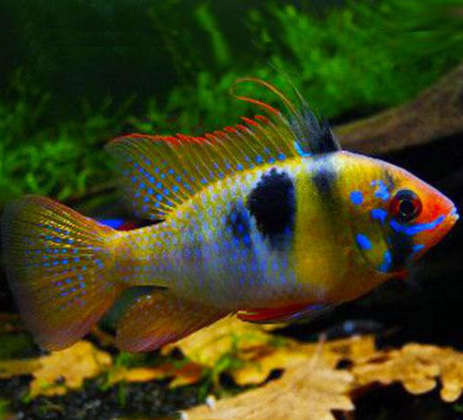
| Information Chart | German Blue Ram |
| Scientific Name: | Mikrogeophagus ramirezi |
| Family: | Cichlidae |
| Care Level: | Moderate to advanced |
| Temperament: | Relatively peaceful |
| Color: | Blue body and gold markings |
| Lifespan: | 2 to 4 years |
| Size: | 2 inches |
| Diet: | Omnivorous |
| Minimum Tank Size: | 20 gallons for a pair |
| Temperature: | 78 to 85F |
| WaterConditions: | pH: 6.0 to 7.5 Soft to moderate water hardness |
| Tank Mate Compatibility | Other peaceful community species |
Popular among aquarists with the name “Butterfly Cichlid,” German Blue Rams are found in the Orinoco River basin in Colombia and Venezuela. Justifying their name, they resemble butterflies in both shape and coloration. Blue Rams prefer to stay in pairs with at least 20 gallons of warm water to swim and explore in. Driftwood, plants, and plenty of hiding spots also are necessary to reduce stress.
German Blue Rams grow faster and exhibit vibrant coloration on an omnivorous diet of high-quality pellets, flakes, brine shrimp, and bloodworms. They also may occasionally accept veggie matter. We feed our Rams twice daily in small amounts for optimum growth and lifespan.
As for water temperature, they thrive in temperatures between 78 to 85 Fahrenheit or 25 to 29 Celcius, but they can sustain a bit warmer temperatures if necessary. Tetras, Rasboras, and other non-aggressive cichlids make compatible tank mates for this species.
3. Neon Tetra
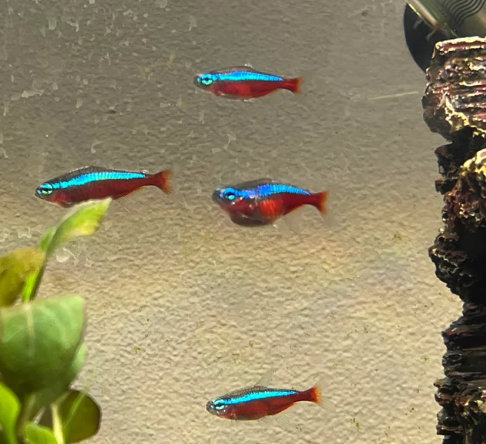
| Information Chart | Neon Tetra |
| Scientific Name: | Paracheirodon innesi |
| Family: | Characidae |
| Care Level: | Easy |
| Temperament: | Peaceful schooling fish |
| Color: | Vibrant, iridescent blue and red stripes |
| Lifespan: | 5 to 10 years |
| Size: | 1.5 inches |
| Diet: | Omnivorous |
| Minimum Tank Size: | 10 gallons for a small school. The larger the better. |
| Temperature: | 72 to 78F |
| WaterConditions: | pH: 6.0 to 7.5 Soft to moderately hard water |
| Tank Mate Compatibility | Other peaceful community fish |
Recognized by iridescent red and blue stripes along their body, Neon Tetras are native to blackwater streams of the Amazon River basin in South America. Emulating their natural practice, Neon Tetras prefer to stay in small groups in tanks of at least 10 gallons. Moreover, they’re pretty timid in nature and appreciate having hiding spaces, such as driftwood and caves, in the tank.
Despite their small size, they have a voracious appetite for high-quality pellets and flakes with occasional live/frozen worms and brine shrimp. We feed our adult Neon Tetras once a day as much as they can eat within a span of 5-7 minutes.
Neon Tetras thrive in water temperatures between 72 to 78 Fahrenheit or 22 to 26 Celcius with a stable low current allowing them to swim peacefully. They’re also pretty suitable for community tanks with similar, non-aggressive fish. But fin-nipping species like Betta Fish should be avoided.
4. Betta Fish
| Information Chart | Betta Fish |
| Scientific Name: | Betta splendens |
| Family: | Osphronemidae |
| Care Level: | Easy to intermediate |
| Temperament: | Aggressive |
| Color: | Variety of colors and fin types |
| Lifespan: | 2 to 4 years |
| Size: | 2.5 to 3 inches |
| Diet: | Carnivorous |
| Minimum Tank Size: | 5 gallons for a single male betta |
| Temperature: | 78 to 80F |
| WaterConditions: | pH: 6.5 to 7.5 Soft to moderate water hardness |
| Tank Mate Compatibility | Usually kept alone or with other peaceful community fish |
Flaring the flowing fins and a variety of colors, Betta Fish, or the Siamese Fighting Fish inhabits shallow, slow-moving waters and rice paddies in Southeast Asian countries of Thailand, Cambodia, and Vietnam. If kept together, male Bettas often engage in aggressive fin flaring and sparring displays. Bettas can be kept in relatively smaller tanks (5 gallons) for their ability to breathe air at the water’s surface.
Bettas are carnivorous species. They prefer small bloodworms, daphnia, and brine shrimp as their primary diet, but show breeders often feed them high-quality Betta pellets or flakes to enhance color and fin/tail growth.
As a warm water fish, Bettas should be kept at a stable temperature of 78 to 80 Fahrenheit or 25 to 27 Celcius. They’re pretty sensitive to water temperature changes and a heater may be required to safeguard their well-being. Non-aggressive, bottom-dwelling tank mates are tolerated by Bettas, but they can grow anxious with the presence of larger fish species in the tank.
5. Freshwater Angelfish
| Information Chart | Angelfish |
| Scientific Name: | Pterophyllum scalare |
| Family: | Cichlidae |
| Care Level: | Intermediate |
| Temperament: | Generally peaceful |
| Color: | Various colors and patterns, such as black, marble, and others. |
| Lifespan: | 10 to 15 years |
| Size: | 6 to 8 inches |
| Diet: | Omnivorous |
| Minimum Tank Size: | 30 gallons for a small group |
| Temperature: | 75 to 82F |
| WaterConditions: | pH: 6.0 to 7.5 Soft to moderate water hardness |
| Tank Mate Compatibility | Other peaceful community species |
Known for their distinctive triangular shape and elegant, trailing fins, freshwater Angelfish are native to the Amazon River Basin in South America. Coming in various colors, such as black, silver, and marble, a small group of these vertical swimmers need at least 30 gallons of water to thrive. Adequate hiding spots are also necessary to emulate their natural ecology.
An omnivorous diet of high-quality pellets and brine shrimp is most suitable for Angelfish, but you may occasionally treat them with live bloodworms, daphnia, and frozen worms. Feed them twice daily for optimum growth and health.
Temperature-wise, Angelfish requires a warm water environment of around 75 to 82 Fahrenheit or 24 to 28 Celcius. Maintaining a consistent temperature is required to sustain Angelfish. They also prefer slow water currents and have a generally peaceful demeanor around other community fish species. However, fin-nipping species may disturb their flowing fins and harm them.
6. Molly
| Information Chart | Molly |
| Scientific Name: | Poecilia spp. |
| Family: | Poeciliidae |
| Care Level: | Easy |
| Temperament: | Generally peaceful |
| Color: | Various colors and patterns, including black, white, orange, and marble. |
| Lifespan: | 3 to 5 years |
| Size: | 3 to 4 inches |
| Diet: | Omnivorous |
| Minimum Tank Size: | 20 gallons for a small group of mollies |
| Temperature: | 75 to 82F |
| WaterConditions: | pH: 7.0 to 8.5 Soft to moderate water hardness |
| Tank Mate Compatibility | Other peaceful community species |
One of the most adaptive livebearer fish species, and found in North and South American freshwater habitats, Mollies come in a variety of colors and patterns. This includes black, silver, orange, and various shades in between. While they don’t grow to a significant size, at least 20 gallons of water is required for a group of mollies to thrive. They also tolerate a wide range of pH and water hardness.
Tropical pellets and frozen bloodworms are the favorite food of Mollies, but our Mollies occasionally love to have live blackworms. A balanced omnivorous diet is necessary to maintain their health and vibrancy. Mollies give birth to live babies who love to feed on brine shrimp and daphnia.
Ensure that your aquarium temperature is within the range of 75 to 82 Fahrenheit or 24 to 28 Celsius and avoid aggressive fish species in community tanks with mollies. Carnivorous fish species should also be avoided.
7. Sterbai Cory Catfish
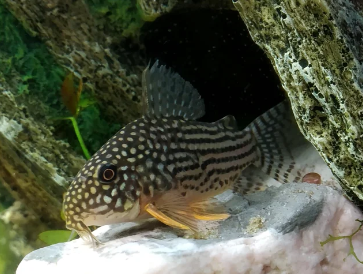
| Information Chart | Sterbai Cory Catfish |
| Scientific Name: | Corydoras sterbai |
| Family: | Callichthyidae |
| Care Level: | Intermediate |
| Temperament: | Peaceful and social. Best kept in groups. |
| Color: | Bronze body with reddish markings |
| Lifespan: | 5 to 7 years |
| Size: | 2.5 inches |
| Diet: | Omnivorous |
| Minimum Tank Size: | 20 gallons for a small group |
| Temperature: | 72 to 78F |
| WaterConditions: | pH: 6.0 to 7.5 Soft to moderately hard water |
| Tank Mate Compatibility | Other small, peaceful community fish |
Native to the upper Rio Guapore in Brazil and Bolivia and named after the Sterbai River in Brazil, the Cory Catfish are recognizable by their distinct dotted pattern of white on their dark body. They live in sandy, soft substrate with dense vegetation and lots of space to swim and explore. Therefore, at least 20 gallons of water is required to house a small group of Cory Catfish. They are, understandably, very social and prefer to live in a group of 3-5.
Their omnivorous diet must include high-quality pellets, flakes, and veggie matter, with occasional inclusion of brine shrimp and bloodworms. Being bottom-dwellers, we prefer to feed our Corydoras sinking pellets. However, contrary to typical catfish behavior, Cories stay active during both day and night.
The water temperature for Cory tanks should be kept between 72-78 Fahrenheit or 22-26 Celcius. While the requirement isn’t as warm as other tropical fish species, you should consider getting a heater for the colder months. Cory Catfish prefer to hide in the rocks and driftwood, but they’re pretty playful and do well in community tanks with non-aggressive fish species.
8. Clown Loach
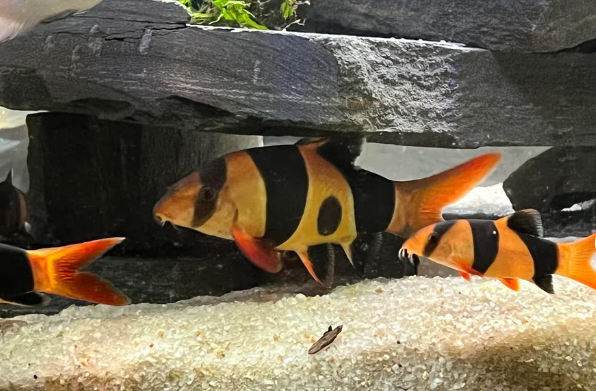
| Information Chart | Clown Loach |
| Scientific Name: | Chromobotia macracanthus |
| Family: | Botiidae |
| Care Level: | Intermediate to Advanced |
| Temperament: | Generally peaceful, but can become territorial. |
| Color: | Vibrant colors with darker bands. |
| Lifespan: | 15 to 20 years with proper care |
| Size: | 8 to 16 inches |
| Diet: | Omnivorous |
| Minimum Tank Size: | 75 gallons for a small group |
| Temperature: | 78 to 86F |
| WaterConditions: | pH: 6.0 to 7.5 Soft to moderate water hardness |
| Tank Mate Compatibility | Other peaceful community fish |
Featuring a bright orange-red body with three black stripes, Clown Loach is native to the inland waters of Sumatra and Borneo. They’re pretty playful and love to stay in the company of more than four. They also can grow pretty huge and active with proper care. So, a tank size of at least 75 gallons is recommended for a small group of Clowns. At the juvenile stage, they exhibit social behavior by playing around the hiding spaces.
Clown Loaches follow an omnivorous diet with leniency towards protein-rich food and, therefore, have a much higher bioload. So, a well-filtered tank with regular water changes is necessary to offer them a healthy environment. High-quality pellets and live worms are preferred food sources for Clown Loaches.
Clowns are warm water fishes and appreciate having water temperatures around 75-86 Fahrenheit or 24-30 Celcius. Unless you’re from the tropical regions, you’ll need a running heater most of the time.
9. Dwarf Gourami
| Information Chart | Dwarf Gourami |
| Scientific Name: | Trichogaster lalius |
| Family: | Osphronemidae |
| Care Level: | Beginner to Intermediate |
| Temperament: | Generally peaceful |
| Color: | Shades of blue, red, and orange |
| Lifespan: | 4 to 6 years |
| Size: | 2 inches |
| Diet: | Omnivorous |
| Minimum Tank Size: | 20 gallons for a pair |
| Temperature: | 77 to 82F |
| WaterConditions: | pH: 6.0 to 7.5 Soft to moderate water hardness |
| Tank Mate Compatibility | Other peaceful community fish |
Breathing air and radiating intricate patterns, the Dwarf Gouramis are native to the South and Southeast Asian countries of India, Pakistan, Bangladesh, and Myanmar. Their vibrant colors and patterns differ with varieties such as Powder Blue and Flame Dwarf Gouramis. While they don’t grow over 2 inches, Dwarf Gouramis have an active swimming style that requires at least 20 gallons of water per pair.
Gouramis prefer a well-planted aquarium with lots of hiding spots and adequate filtration. Water changes also need to be exercised frequently for Dwarf Gouramis to thrive. They have a high appetite and accept a varied omnivorous diet of small live and frozen foods with high-quality pellets and flakes to maintain their color and growth.
Being a tropical fish species, Dwarf Gouramis need water temperatures between 77-82F or 25-28C. Although they’re typically pretty peaceful, they often show territorial behavior towards other Gouramis and similarly sized community fish.
10. Cardinal Sulawesi Shrimp
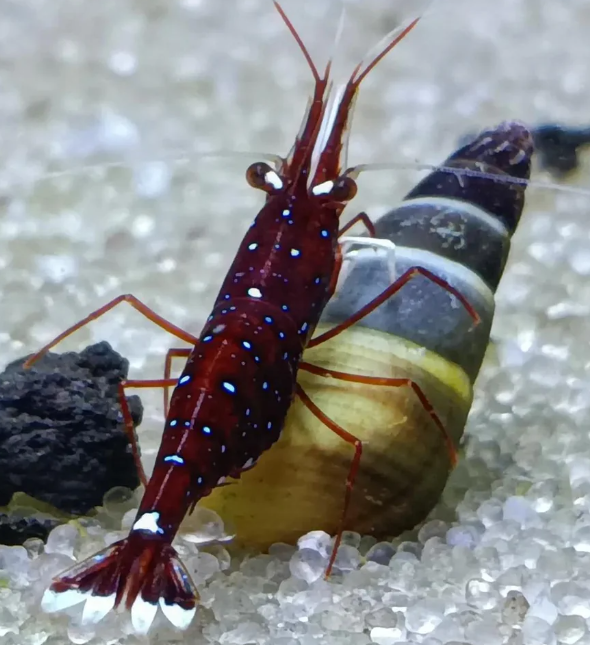
| Information Chart | Cardinal Sulawesi Shrimp |
| Scientific Name: | Caridina dennerli |
| Family: | Atyidae |
| Care Level: | Intermediate to advanced |
| Temperament: | Peaceful |
| Color: | Striking red and white |
| Lifespan: | 1 to 2 years |
| Size: | 1 to 1.5 inches |
| Diet: | Omnivorous |
| Minimum Tank Size: | 10 gallons for a small community |
| Temperature: | 70 to 75F |
| WaterConditions: | pH: 7.5 to 8.5 Soft to moderate water hardness |
| Tank Mate Compatibility | Non-aggressive fish species |
The small, red, vibrant Cardinal Sulawesi Shrimp are native to the Sulawesi island in Indonesia. These relatively small shrimps have white stripes along their body. Known for being peaceful and non-aggressive, Sulawesi Shrimps are suitable for planted community tanks. They also can thrive in smaller tanks with 10 gallons of water.
However, they require slightly alkaline water with a 7.5 – 8.5 pH level and a well-established ecosystem. You would also need to provide them with lots of hiding space and plants to emulate their natural habitat. While they feed on algae wafers and blanched veggies, they generally prefer an omnivorous diet of pellets and flakes.
Cardinal Sulawesi Shrimp are pretty vulnerable to predation and may get intimidated by larger fish with an aggressive nature. Keep them in community tanks with smaller and more peaceful fish species like Mollies and Guppies.
Also Read: Galaxy Rasbora: Full Care Guide, Breeding, Tank Size & Disease
FAQs
Tropical fish are found in warm waters. Discus, Blue Rams, Tetras, and many other fancy aquarium fish species are common in warm waters.
Warm water fish are those fish species that inhabit relatively warmer water above 78 Fahrenheit.
Warm-water fish have a greater metabolic rate than cold-water fish. They also are smaller than cold water species. In the aquarium trade, warm-water fish species are considered more colorful and easy to care for than their cold-water counterparts.
The Bottom Line
We’ve discussed the top 10 warm water fish that are found in the aquarium trade. Hopefully, you’ll now be able to choose the best ones for your new tank and care for them properly.

